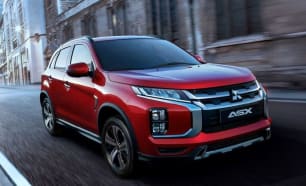Compared to before, the 2021 GLA is some 122mm taller, so ushers in a higher hip point for loftier seating – reducing that jumped-up hatch feel. Headroom improves obviously, as does rear legroom, a corollary of a 30mm wheelbase stretch (to 2729mm).
Wide apertures also make entry into and out of the German-built GLA child's play, though the solid heft of their doors is serious business at this end of the segment, very satisfyingly Teutonic and totally on-brand. This is something you won’t enjoy in a Subaru XV.
Then you s-c-r-a-p-e the underside of the front doors on the pavement literally every time you swing it to get out, and wonder whether Mercedes engineers have ever been to Australia. This fail drove us spare. Heaven help the GLAs in towns and cities with bluestone sidewalks. Maybe all that extra AMG packaging is the culprit.
Still, most of the other basics are spot-on and can’t really be faulted; cosy yet spacious for four adults – especially up front, ample vision, an excellent driving position aided by heaps of seat and steering wheel adjustability, cosseting front sports buckets that you just sink into, torrents of ventilation from those delectable turbine vents and stacks of storage. Collectively they make the GLA a welcoming, opulent place to travel in. Only the hapless fifth occupant squished between the outboard rear-seat passengers might think otherwise. But nobody buys this Benz for carting people around. That's the GLB's job.
Several years ago, Daimler poached a senior Audi designer and since then Mercedes’ dashboards have morphed into a multi-coloured multimedia diorama of touchscreen technology that threatens to completely take over the universe. Choose the right combination of colours and lighting and it's like your very own White Night on wheels. Starting with 2018’s A-Class, the striking, spangly MBUX system that underpins all this has come to be widely admired and imitated. For aesthetics anyway, with its vivid hues, panoramic displays and simple, tiled applications, it’s been a real trip.
Anyway, back to reality. From a tactility and functionality point of view, there’s still work to be done.
Access to the multimedia (including our GLA's banging optional audio system) and car settings areas is possible via a mildly fiddly finger-pad arrangement down forward in the centre console, or smaller yet much more annoying thumb sensor tabs on the wheel spokes. These are not easy to modulate on the move. Additionally, their menus can be confusing to navigate through and sometimes counterintuitive in operation. Mercedes obviously realises this as a quick-guide pamphlet is provided on old-fashioned cardboard paper. How quaint.
Eventually all areas can be mastered over time, but the functionality is complicated and may overwhelm the not-so-tech savvy. Additionally, the ‘Hey, Mercedes!’ voice control is impressive for getting MBUX to perform basic multimedia and vehicle settings-related changes, but it too-often erratic, unreliable and ultimately frustrating for more complicated commands. Perhaps elocution lessons on behalf of the operator may help.
But not as much as the profound disappointment we endure from the cheapness of some of the materials, the wincing cellophane-like sounds when pressing on some of the surfaces such as the door cards, or that emanate after a particularly bumpy section of bad roads. Sheeny reflections and hard textures in a car optioned with extras that total up to nearly $82,500 just don’t cut it.
At least in this latest-gen GLA, the rear seat area seems much improved over the previous models, with more space, comfy and supportive seating (remember ours featured the $607 sliding function that ought to be standard) and a reclining backrest. All amenities are present, with deep pockets, fresh air from twin vent outlets, reading lights and thoughtfully placed armrests – but, again, the latter’s extendable cupholders feel brittle and cheap.
Further back, the 435-litre cargo area is sufficiently sized and practical for smaller family use (at last), aided by a 40/20/40 backrest fold and that slide-able cushion to extend capacity further. There is no spare wheel, but a tyre inflation kit is fitted in lieu.
Overall, then, better than before, with that fundamental rock-solid heft, luxurious aura and alluring premium-car aroma. The dazzling MBUX screen-related visuals, too, are endlessly entertaining to explore when the vehicle is not moving, but the GLA’s cabin is still not quite up to Mercedes’ reputation for exacting over-engineered excellence.
Or even to the standards of some mainstream alternatives.

